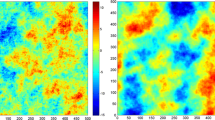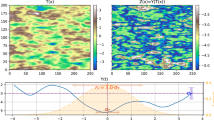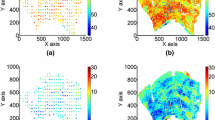Abstract
Random field theory has been increasingly adopted to simulate spatially varying environmental properties and hydrogeological data in recent years. In a two-dimensional (2D) stochastic analysis, variation of the environmental properties or hydrogeological data along different directions can be similar (i.e., isotropic) or quite different (i.e., anisotropic). To model the spatially isotropic or anisotropic variability in a stochastic analysis, conventional random field generators generally require a vast amount of measurement data to identify the random field parameters (e.g., mean, variance, and correlation structure and correlation length in different directions). However, measurement data available in practice are usually sparse and limited. The random field parameters estimated from sparse measurements might be unreliable, and the subsequent random field modeling or stochastic analysis might be misleading. This underscores the significance and challenge of generating 2D isotropic or anisotropic random fields from sparse measurements. This paper develops a novel 2D random field generator, which does not require a parametric form of correlation function or estimation of correlation length and other random field parameters, and directly generates 2D isotropic or anisotropic random field samples from sparse measurements. The proposed generator is highly efficient because simulation of a 2D random field is achieved by generation of a short 1D random vector. The effectiveness and applicability of the proposed generator are illustrated using isotropic and anisotropic numerical examples.




















Similar content being viewed by others
References
Adler RJ, Taylor JE (2009) Random fields and geometry. Springer, Berlin
Ahmed AA (2012) Stochastic analysis of seepage under hydraulic structures resting on anisotropic heterogeneous soils. J Geotech Geoenviron Eng 139:1001–1004
Allard DJ-P, Chilès P (2013) Delfiner geostatistics: modeling spatial uncertainty. Springer, Berlin
Allcroft DJ, Glasbey CA (2003) A latent Gaussian Markov random-field model for spatiotemporal rainfall disaggregation. J R Stat Soc Ser C Appl Stat 52:487–498
Au SK, Wang Y (2014) Engineering risk assessment with subset simulation. Wiley, Hoboken
Baecher GB, Christian JT (2003) Reliability and statistics in geotechnical engineering. Wiley, Hoboken
Bellehumeur C, Legendre P, Marcotte D (1997) Variance and spatial scales in a tropical rain forest: changing the size of sampling units. Plant Ecol 130(1):89–98
Böttcher F, Peinke J (2007) Small and large scale fluctuations in atmospheric wind speeds. Stoch Environ Res Risk Assess 21:299–308
Candès EJ, Wakin MB (2008) An introduction to compressive sampling. IEEE Signal Process Mag 25:21–30
Cao Z, Wang Y (2014) Bayesian model comparison and selection of spatial correlation functions for soil parameters. Struct Saf 49:10–17
Christakos G (2012) Random field models in earth sciences. Courier Corporation, Chelmsford
Davis MW (1987) Production of conditional simulations via the LU triangular decomposition of the covariance matrix. Math Geol 19:91–98
DeGroot MH (2004) Optimal statistical decisions. Wiley, New Jersey
Dietrich C, Newsam G (1993) A fast and exact method for multidimensional Gaussian stochastic simulations. Water Resour Res 29:2861–2869
Donoho DL (2006) Compressed sensing. IEEE Trans Inf Theory 52:1289–1306
Donoho D, Maleki A, Shahram M (2006) Wavelab 850. Software toolkit for time-frequency analysis
Dormann F, Carsten et al (2007) Methods to account for spatial autocorrelation in the analysis of species distributional data: a review. Ecography 30(5):609–628
Elkateb T, Chalaturnyk R, Robertson PK (2003) An overview of soil heterogeneity: quantification and implications on geotechnical field problems. Can Geotech J 40:1–15
Emery X, Arroyo D, Porcu E (2016) An improved spectral turning-bands algorithm for simulating stationary vector Gaussian random fields. Stoch Environ Res Risk Assess 30:1863–1873
Fang Y, Wu J, Huang B (2012) 2D sparse signal recovery via 2D orthogonal matching pursuit. Sci China Inform Sci 55:889–897
Fernández-Pascual RM, Espejo R, Ruiz-Medina MD (2016) Moment and Bayesian wavelet regression from spatially correlated functional data. Stoch Environ Res Risk Assess 30(2):523–557
Franco C, Soares A, Delgado J (2006) Geostatistical modelling of heavy metal contamination in the topsoil of Guadiamar river margins (S Spain) using a stochastic simulation technique. Geoderma 136:852–864
Huang S, Quek S, Phoon K (2001) Convergence study of the truncated Karhunen-Loeve expansion for simulation of stochastic processes. Int J Numer Methods Eng 52:1029–1043
Ji S, Xue Y, Carin L (2008) Bayesian compressive sensing. IEEE Trans Signal Process 56:2346–2356
Jiang SH, Li DQ, Zhang LM, Zhou CB (2014) Slope reliability analysis considering spatially variable shear strength parameters using a non-intrusive stochastic finite element method. Eng Geol 168:120–128
Johnson RA, Wichern DW (2002) Applied multivariate statistical analysis. Prentice Hall, Upper Saddle River
Kim HM, Mallick BK (2004) A Bayesian prediction using the skew Gaussian distribution. J Stat Plan Infer 120:85–101
Kitterrød N-O, Gottschalk L (1997) Simulation of normal distributed smooth fields by Karhunen–Loéve expansion in combination with kriging. Stoch Hydrol Hydraul 11:459–482
Li H, Zhang D (2013) Stochastic representation and dimension reduction for non-Gaussian random fields: review and reflection. Stoch Environ Res Risk Assess 27(7):1621–1635
Luo N, Bathurst RJ (2017) Probabilistic analysis of reinforced slopes using RFEM and considering spatial variability of frictional soil properties due to compaction. Georisk 12:87–108
MathWorks I (2016) MATLAB: the language of technical computing. http://www.mathworks.com/products/matlab/
Modis K, Papantonopoulos G, Komnitsas K, Papaodysseus K (2008) Mapping optimization based on sampling size in earth related and environmental phenomena. Stoch Environ Res Risk Assess 22:83–93
Montoya-Noguera S, Zhao T, Hu Y, Wang Y, Phoon KK (2019) Simulation of non-stationary non-Gaussian random fields from sparse measurements using Bayesian compressive sampling and Karhunen–Loève expansion. Struct Saf 79:66–79
Murphy KP (2007) Conjugate Bayesian analysis of the Gaussian distribution, Technical report. University of British Columbia, Vancouver
Phoon KK (2017) Role of reliability calculations in geotechnical design. Georisk 11:4–21
Phoon K, Huang S, Quek S (2002) Simulation of second-order processes using Karhunen-Loeve expansion. Comput Struct 80:1049–1060
Pietrogrande MC, Bacco D, Marchetti N, Mercuriali M, Zanghirati G (2011) 2D autocovariance function for comprehensive analysis of two-way GC–MS data matrix: application to environmental samples. Talanta 83:1225–1232
Pyrcz MJ, Deutsch CV (2014) Geostatistical reservoir modeling. Oxford University Press, Oxford
Rapaka S, Pawar RJ, Stauffer PH, Zhang D, Chen S (2009) Onset of convection over a transient base-state in anisotropic and layered porous media. J Fluid Mech 641:227–244
Reed PM, Ellsworth TR, Minsker BS (2004) Spatial interpolation methods for nonstationary plume data. Groundwater 42:190–202
Rubinstein RY, Kroese DP (2016) Simulation and the Monte Carlo method. Wiley, Hoboken
Schwarzl M, Godec A, Metzler R (2017) Quantifying non-ergodicity of anomalous diffusion with higher order moments. Sci Rep 7(1):3878
Shi L, Yang J, Zhang D (2009) A stochastic approach to nonlinear unconfined flow subject to multiple random fields. Stoch Environ Res Risk Assess 23:823–835
Sivia D, Skilling J (2006) Data analysis: a Bayesian tutorial. Oxford University Press, Oxford
Smith RL, Kolenikov S, Cox LH (2003) Spatiotemporal modeling of PM2. 5 data with missing values. J Geophys Res: Atmos 108 (D24)
Spanos PD, Ghanem R (1989) Stochastic finite element expansion for random media. J Eng Mech 115:1035–1053
Stefanou G, Papadrakakis M (2007) Assessment of spectral representation and Karhunen–Loève expansion methods for the simulation of Gaussian stochastic fields. Comput Method Appl M 196:2465–2477
Strang G (1993) Introduction to linear algebra. Wellesley-Cambridge Press Wellesley, MA
Stuedlein AW, Kramer SL, Arduino P, Holtz RD (2012) Geotechnical characterization and random field modeling of desiccated clay. J Geotech Geoenviron Eng 138(11):1301–1313
Tian M, Li DQ, Cao ZJ, Phoon KK, Wang Y (2016) Bayesian identification of random field model using indirect test data. Eng Geol 210:197–211
Tipping ME (2001) Sparse Bayesian learning and the relevance vector machine. J Mach Learn Res 1:211–244
Tobin PC (2004) Estimation of the spatial autocorrelation function: consequences of sampling dynamic populations in space and time. Ecography 27(6):767–775
Tompson AF, Ababou R, Gelhar LW (1989) Implementation of the three-dimensional turning bands random field generator. Water Resour Res 25:2227–2243
Vanmarcke E (2010) Random fields: analysis and synthesis. World Scientific, Singapore
Vanmarcke E, Grigoriu M (1983) Stochastic finite element analysis of simple beams. J Eng Mech 109:1203–1214
Vargas-Guzmán J (2003) Conditional components for simulation of vector random fields. Stoch Environ Res Risk Assess 17:260–271
Wang Y, Cao Z (2013) Probabilistic characterization of Young’s modulus of soil using equivalent samples. Eng Geol 159:106–118
Wang Y, Zhao T (2016) Interpretation of soil property profile from limited measurement data: a compressive sampling perspective. Can Geotech J 53:1547–1559
Wang Y, Zhao T (2017) Statistical interpretation of soil property profiles from sparse data using Bayesian compressive sampling. Géotechnique 67:523–536
Wang Y, Au SK, Cao Z (2010) Bayesian approach for probabilistic characterization of sand friction angles. Eng Geol 114:354–363
Wang Y, Au SK, Kulhawy FH (2011) Expanded reliability-based design approach for drilled shafts. J Geotech Geoenviron Eng 137:140–149
Wang Y, Cao Z, Li D (2016) Bayesian perspective on geotechnical variability and site characterization. Eng Geol 203:117–125
Wang Y, Akeju OV, Zhao T (2017a) Interpolation of spatially varying but sparsely measured geo-data: a comparative study. Eng Geol 231:200–217
Wang Y, Fu C, Huang K (2017b) Probabilistic assessment of liquefiable soil thickness considering spatial variability and model and parameter uncertainties. Gèotechnique 67(3):228–241
Wang Y, Zhao T, Phoon KK (2018) Direct simulation of random field samples from sparsely measured geotechnical data with consideration of uncertainty in interpretation. Can Geotech J 55(6):862–880
Webster R, Oliver MA (2007) Geostatistics for environmental scientists. Wiley, Hoboken
Zhang D (2001) Stochastic methods for flow in porous media: coping with uncertainties. Elsevier, Amsterdam
Zhang D, Lu Z (2004) An efficient, high-order perturbation approach for flow in random porous media via Karhunen–Loeve and polynomial expansions. J Comput Phys 194(2):773–794
Zhao T, Wang Y (2018) Simulation of cross-correlated random field samples from sparse measurements using Bayesian compressive sensing. Mech Syst Sig Process 112:384–400
Zhao T, Montoya-Noguera S, Phoon KK, Wang Y (2018a) Interpolating spatially varying soil property values from sparse data for facilitating characteristic value selection. Can Geotech J 55(2):171–181
Zhao T, Hu Y, Wang Y (2018b) Statistical interpretation of spatially varying 2D geo-data from sparse measurements using Bayesian compressive sampling. Eng Geol 246:162–175
Zhu H, Zhang LM (2013) Characterizing geotechnical anisotropic spatial variations using random field theory. Can Geotech J 50:723–734
Acknowledgements
The work described in this paper was supported by grants from the Research Grants Council of the Hong Kong Special Administrative Region, China (Project Nos. CityU 11225216 and T22-603/15N). The financial supports are gratefully acknowledged.
Author information
Authors and Affiliations
Corresponding author
Additional information
Publisher's Note
Springer Nature remains neutral with regard to jurisdictional claims in published maps and institutional affiliations.
Rights and permissions
About this article
Cite this article
Hu, Y., Zhao, T., Wang, Y. et al. Direct simulation of two-dimensional isotropic or anisotropic random field from sparse measurement using Bayesian compressive sampling. Stoch Environ Res Risk Assess 33, 1477–1496 (2019). https://doi.org/10.1007/s00477-019-01718-7
Published:
Issue Date:
DOI: https://doi.org/10.1007/s00477-019-01718-7




